Valve Block - Air Suspension (Remove and Replace)
 Correction code
311022021.14
NOTE: Unless otherwise explicitly
stated in the procedure, the above correction code and FRT reflect all of the work
required to perform this procedure, including the linked procedures. Do not stack correction codes unless
explicitly told to do so.
NOTE: See Flat Rate Times to learn
more about FRTs and how they are created. To provide feedback on FRT values, email ServiceManualFeedback@tesla.com.
NOTE: See Personal Protection to make sure proper PPE is worn when
performing the below
procedure.
Correction code
311022021.14
NOTE: Unless otherwise explicitly
stated in the procedure, the above correction code and FRT reflect all of the work
required to perform this procedure, including the linked procedures. Do not stack correction codes unless
explicitly told to do so.
NOTE: See Flat Rate Times to learn
more about FRTs and how they are created. To provide feedback on FRT values, email ServiceManualFeedback@tesla.com.
NOTE: See Personal Protection to make sure proper PPE is worn when
performing the below
procedure.
Remove
- Raise the vehicle on a 2 post lift. See Raise Vehicle - 2 Post Lift.
- Connect a laptop with Toolbox to the vehicle. See Toolbox (Connect and Disconnect).
- Select the Actions tab and search for "TAS service mode".
-
Select PROC_TAS_X_ENTER-SERVICE-MODEvia Toolbox: (link), click Run, and allow the routine
to complete.
- Select the Actions tab and search for "Deflate".
- Select PROC_TAS_X_DEFLATEvia Toolbox: (link)via Service Mode: Chassis ➜ Suspension ➜ Deflate, click Run, and allow the routine to complete.
-
Remove the laptop from vehicle.
NoteToolbox will be used again later.
- Remove the front fascia from the vehicle. See Fascia Assembly - Front (Remove and Install).
-
Raise the vehicle fully and lower the
lift onto the locks.
NoteSet the vehicle to a comfortable working height, Make sure there's an audible click of the locks on both sides before lowering, otherwise vehicle may tilt to the side
-
Release the locking tabs, and then
disconnect the electrical harnesses (x2) from the air suspension compressor.
-
Release the clip that attaches the air
compressor electrical harness to the air compressor carrier.
NoteTake note of how the harness is routed to aid in reinstallation.
-
Release the nuts (x2) that attach the
air lines to the air compressor, and then remove the lines from the compressor.
 2 Nm (1.5 lbs-ft)NoteUse of the following tool(s) is recommended:
2 Nm (1.5 lbs-ft)NoteUse of the following tool(s) is recommended:- 10 mm combination wrench
- 12 mm combination wrench
-
Remove the collets from both air
lines, and then discard the collets (x2) and VOSS fittings (x2).
NoteUse of the following tool(s) is recommended:
- Small slotted screwdriver
-
Remove the fastener assemblies (x3)
that attach the air suspension compressor carrier bracket to the air suspension
compressor bracket, and then support the compressor.
 5 Nm (3.7 lbs-ft)CAUTIONThe air compressor will drop once the fasteners are removed. Support the compressor with hangers and bungee cords.NoteThe fastener assemblies consist of the spring, spring seat, and isolator.TIpUse of the following tool(s) is recommended:
5 Nm (3.7 lbs-ft)CAUTIONThe air compressor will drop once the fasteners are removed. Support the compressor with hangers and bungee cords.NoteThe fastener assemblies consist of the spring, spring seat, and isolator.TIpUse of the following tool(s) is recommended:- Torx T30 socket
- 2 in extension
-
Release the hose clip, remove the
intake hose from the air compressor, and then remove the air compressor from the
vehicle.
TIpUse of the following tool(s) is recommended:
- Needle nose pliers
-
Release the locking tab, and then
disconnect the electrical harness from the air suspension valve block.
-
Release the nuts (x4) that attach the
air spring lines to the valve block, and then remove the air lines from the valve
block.
 2 Nm (1.5 lbs-ft)TIpUse of the following tool(s) is recommended:
2 Nm (1.5 lbs-ft)TIpUse of the following tool(s) is recommended:- 10 mm combination wrench
-
Release the nut that attaches the
reservoir line to the air suspension valve block, and then remove the air line from the
valve block.
 3.5 Nm (2.6 lbs-ft)TIpUse of the following tool(s) is recommended:
3.5 Nm (2.6 lbs-ft)TIpUse of the following tool(s) is recommended:- 12 mm combination wrench
-
Release the nut that attaches the air
compressor line to the valve block, and then remove the air line from the valve
block.
 3.5 Nm (2.6 lbs-ft)TIpUse of the following tool(s) is recommended:
3.5 Nm (2.6 lbs-ft)TIpUse of the following tool(s) is recommended:- 12 mm combination wrench
-
Release the nut that attaches the
boost line to the valve block, and then remove the air line from the valve block.
 2 Nm (1.5 lbs-ft)TIpUse of the following tool(s) is recommended:
2 Nm (1.5 lbs-ft)TIpUse of the following tool(s) is recommended:- 10 mm combination wrench
-
Remove the collets (x7) from the air
lines that were released from the valve block, and then discard the collets and VOSS
fittings (x7).
NoteUse of the following tool(s) is recommended:
- Small slotted screwdriver
-
Remove the bolts (x2) that attach the
air suspension valve block to the air suspension compressor bracket, and then remove the
valve block from the vehicle.
Install
-
Position the new air suspension valve
block on the vehicle and install the bolts (x2) that attach the air suspension valve
block to the air suspension compressor bracket.
 5 Nm (3.7 lbs-ft)TIpUse of the following tool(s) is recommended:
5 Nm (3.7 lbs-ft)TIpUse of the following tool(s) is recommended:- Torx T30 socket
- 6 in extension
-
Remove the plastic plugs (x7) from the
air suspension valve block.
-
Press the boost line into the boost
line fitting on the valve block. Align the marking on the hose with the top of the
fitting.
NotePerform a push-pull-push test.
-
Press the air compressor line into the
air compressor line fitting on the valve block. Align the marking on the hose with the
top of the fitting.
NotePerform a push-pull-push test.
-
Press the reservoir line into the
reservoir line fitting on the valve block. Align the marking on the hose with the top of
the fitting.
NotePerform a push-pull-push test.
-
Press the air spring lines (x4) into
the air spring line fittings on the valve block. Align the markings on the hoses with
the top of the fittings.
NoteMatch the colors of the air spring line sleeves with the colors of the label on top of the valve block.NotePerform a push-pull-push test.
-
Connect the electrical harness to the
air suspension valve block and make sure the locking tab is engaged.
-
Install the intake hose on the air
compressor and secure the hose clip.
NoteIf needed, support the compressor with hangers and bungee cords.TIpUse of the following tool(s) is recommended:
- Needle nose pliers
-
Remove any bungee cords from the air
suspension compressor carrier bracket assembly, position the compressor carrier bracket
assembly on the compressor bracket, and then install the fastener assemblies (x3) that
attach the carrier bracket to the compressor bracket.
 5 Nm (3.7 lbs-ft)TIpUse of the following tool(s) is recommended:
5 Nm (3.7 lbs-ft)TIpUse of the following tool(s) is recommended:- Torx T30 socket
- 2 in extension
-
Install the clip that attaches the air
compressor electrical harness to the air compressor carrier.
NoteRoute the electrical harness along the carrier bracket.
-
Connect the electrical harnesses (x2)
to the air suspension compressor, making sure the locking tabs engage.
-
Install new VOSS fittings (x2) on the air suspension compressor.
 2 Nm (1.5 lbs-ft)NoteUse of the following tool(s) is recommended:
2 Nm (1.5 lbs-ft)NoteUse of the following tool(s) is recommended:- 10 mm deep socket
- 12 mm deep socket
- Remove the plugs (x2) from the VOSS fittings on the air compressor.
-
Press the air lines (x2) into the air
compressor VOSS fittings. Align the top of the VOSS fittings between the 2 white
markings on the air lines.
NotePerform a push-pull-push test.
- Install the front fascia on the vehicle and reconnect the FRL and LV battery connector, but do not install any underhood trim panels. See Fascia Assembly - Front (Remove and Install).
- Refill the air suspension reservoir. See Refill the Reservoir.
- Install the remaining components, and then remove the vehicle from the lift. See Fascia Assembly - Front (Remove and Install).